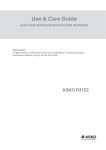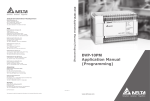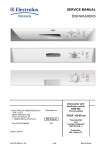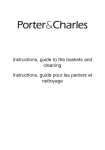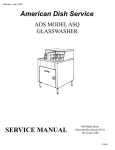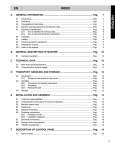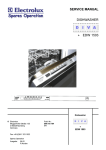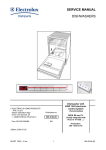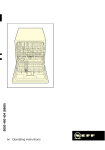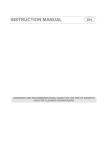Download Asko D1996 Use & Care Manual
Transcript
ur of good use of yo s ar ye y an m t you will ge ST O M ER se of your D EA R A SK O CU s. We hope that er m o st cu best possible u t O K ge S A to f o er y il rd o m fa use the cated. In Welcome to the is very sophisti uide before you G er e h ar as C w d h is an d se e . Th ad this U new dishwasher mend you to re m co re e w s n io l its funct machine and al dishwasher. Use & Care Guide ASKO D1996 SERVICE & GUARANTEE SERVICE Before calling for service, check to see whether the faults is due to something that you can put right yourself. See Trouble shooting pages 24-25. GUARANTEE For guarantee details, see the guarantee card. 2 CONTENTS READ FIRST Safety Children’s safety The parts of the dishwasher Technical data Baskets Dispenser Control panel, symbols CARE 4 5 6 6 7 8 8 HOW TO USE THE DISHWASHER Before you start Basic instructions Standard programmes Programme options Eco wash Delicate and sensitive washing up 9 9-11 12 13 14 15 Cleaning Rinse aid Salt 16-17 18 19 SETTINGS Settings 20-22 FAULTS Fault indications Trouble shooting - Results Trouble shooting - Dishwasher 23 24-25 26 MISCELLANEOUS Performance information Quick guide 27 28 INSTALLATION See instructions for installation INDEX Children’s safety 5 Crystal glass, see Delicate wash Degree of hardness, see water hardness Delicate wash 15 Detergent 8, 10 Dispenser 8 Disposal 4 Energy consumption 12 Energy saving 12-14 Environment 4, 9, 12-14 Lime deposits 16 Options 13 Plastic items, see Delicate wash Poor results 16-19, 24-25 Programmes 12-13 Quick guide 28 Rinse aid 18 Safety 4-5 Salt 19 SCS (Super Cleaning System™) 9 Service 2 Settings 20-22 Silver, see Delicate wash Times 12 Water consumption 12 Water setting, see Installation Water softener 19, 22 Water hardness 9, 18-19, 22 Wetting agent, see Rinse aid Winter storage 4 3 SAFETY GENERAL PULL-LATCH (FULLY INTEGRATED MACHINES ONLY) • Study and save the operating instructions for future reference. • Services to the dishwasher, ie, water supply, drain, electric power, should be connected by an authorized person. • Do not use the dishwasher for other purposes than those stated in the operating instructions. • Do not subject the dishwasher door or the baskets to any other load in addition to the dishware. •Use only dishwasher detergent. • Place cutlery and other sharp objects so that they cannot cause injury, or damage to the appliance. •Do not touch the heating element at the bottom of the dishwasher - it is very hot during and for a period following the dishwashing process. Never place items containing remains of solvents in the machine, ie, danger of explosion. Dishware containing ashes, wax or lubricating grease may not be washed in the machine. Place objects made of wood or plastic in the upper basket, ie, so that they do not fall down onto the heating element at the bottom of the machine (fire hazard). The machine will stop if the door is opened during operation. However, since the machine is fitted with a pull-latch, splashing may occur if the door is opened too quickly. Therefore, unlatch the door carefully and wait until the spray arms have stopped rotating before opening fully. INSTALLATION See the enclosed instructions for installation. TRANSPORT/WINTER STORAGE Transport the machine in an upright position or lying on its back. Drain off all water from the drain pump and the inlet valve if the machine is to be transported, or stored in unheated premises, in the winter - call your local dealer. 4 OVERFILL PROTECTION The overfill protection starts the drain pump and switches off the water inlet if water rises above the normal level. If the overfill protection becomes activated, turn off the water supply and call for service. CLEANING Use only a damp cloth to clean the edge around the door. Do not use a spray. Water can enter the lock and come into contact with the electric components. WRAPPINGS Sort the wrapping material according to recommendations by the local authorities. DISPOSAL When the machine is no longer useful and is to be scrapped it should be made unusable. Disconnect and cut off the electric cable close to the machine. Get in touch with the refuse collection service or your local authorities for advice on how to scrap the machine in a proper manner. The machine is made and marked for recycling. CHILDREN’S SAFETY ! CHILD-SAFE STOPPING AND STARTING CHILD-SAFE DISHWASHING To stop a dishwashing programme, the stop button must be pressed for three seconds. This delay is integrated. To prevent the machine from being started by mistake by a child, it is possible to programme a similar delay in the starting mode, see Settings. Use the knife basket, or the knife rack, for all long or sharp items. If this feature is not fitted, put such objects in the cutlery basket with the sharp edge downwards. Always close the door and start the programme as soon as you have filled with detergent. Keep small children away from the machine when it is open. There may be remains of detergent left inside the machine. Do not allow children to use or play with the machine. Take particular care when the door is open. MACHINE WITH CHILD-SAFETY LOCK? To activate the child-safety lock, if fitted, lift and turn the screw slot with a screwdriver to a horizontal position. The screw slot is located to the left of the handle. Reset by turning the slot to its vertical position. To open the door, hold the catch with your left hand and pull the main catch with your right hand in the usual way. To open the door, hold the catch with your left hand and pull the main catch with your right hand in the usual way. PROTECT CHILDREN - MACHINE DETERGENT IS CORROSIVE Keep detergent and rinse aid out of the reach of children. If anyone swallows dishwasher detergent, give plenty to drink immediately, ie, one or two glasses of milk or water. Do not try to induce vomiting. Seek medical advice without delay. If dishwasher detergent gets in the eyes, rinse with plenty of water for at least 15 minutes. 5 THE PARTS OF THE DISHWASHER* 1 1. KNIFE BASKET 2. UPPER BASKET 3. LAMP 4. SPRAY ARMS 2 5.LOWER BASKET 6. CUTLERY BASKET 7. RINSE AID FILLING 8. RINSE AID DISPENSER 3 9. DETERGENT COMPARTMENT 4 10. MAIN POWER SWITCH 5 11. PROGRAMME PANEL 6 12 8 13 12. COARSE FILTER 7 9 13. FINE FILTER 14. TYPE PLATE * Deviations may occur depending on the model and the market concerned. 10 11 14 TECHNICAL DATA HEIGHT 820–890 MM WIDTH 596 MM DEPTH 550 MM**** WEIGHT 48 KG/51 KG WITH SOFTENER* CAPACITY** 14 COVERS WATER PRESSURE 0,03–1,0 MPA (0,3–10 KP/CM2) MAX. TEMPERATURE INLET-WATER 80° C POWER SUPPLY SINGLE PHASE, 230 V, 50HZ 10/16A*** MAX. CONNECTING POWER 2 000 W*** ACCESSORIES WORKTOP, SIDE PLATES, ANTI-TIP DEVICE, TRIMMING FRAMES **According to standard, AS/NZS 2007.1. ***See type plate. ****Without wooden door fitted. 6 DISHWARE BASKETS* Upper basket 1 2 3 Lower basket 4 1. ADJUSTABLE AND FOLDING RACKS 2. DIVIDED CUP SHELF 3. FOLDABLE GLASS THREAD 4. LOWER BASKET 5. CUTLERY BASKET WITH ADJUSTABLE AND FOLDING COVER 6. KNIFE RACK Cutlery basket 5 * Deviations may occur depending on the model and the market concerned. Knife rack 6 7 CONTROL PANEL* 2 12 13 3 1 4 5 6 PROGRAMMES 7 8 9 10 11 OPTIONS 1. MAIN POWER SWITCH 8. TEMPERATURE CHOICE 2. INDICATION LAMPS 9. DRYING HEAT 3. INTENSIVE WASH 10. DELAYED START 4. NORMAL WASH 11. START/STOP 5. QUICK WASH 12. RINSE-AID INDICATION 6. RINSE & HOLD 13. SALT INDICATION 7. ECO/BIO-FUNCTION * Deviations may occur depending on the model and the market concerned. DISPENSER 1 2 3 1. COMPARTMENT FOR MAIN WASH DETERGENT 2. COMPARTMENT FOR PRE-WASH DETERGENT 3. RINSE-AID INDICATOR 4. RINSE-AID LID 5. DETERGENT COMPARTMENT LID 4 5 8 BEFORE USING THE DISHWASHER FOR THE FIRST TIME: READ THE OPERATING INSTRUCTIONS Read through the operating instructions before attempting to use the dishwasher, particularly the sections: Safety, Children’s safety, and Basic instructions. BE CAUTIOUS WITH CERTAIN MATERIALS Read the Delicate wash section before washing any porcelain or china that has “on-glaze“ decoration, or crystal glassware, or items made of wood or plastic material. it stop exactly where you released it? If not, check the installation instructions or consult the person responsible for the installation. CHECK HARDNESS OF THE WATER Call your local water company to find out what degree of water hardness applies. This has significance in relation to the amount of detergent and rinse aid that should be dispensed. IF YOUR MACHINE IS EQUIPPED WITH A WATER SOFTENER CHECK THE DOOR SETTING Ensure that the door of the machine is properly balanced, ie, open it a little and release it. Does Set the softener when you know what degree of water hardness applies, see Softener. Fill with salt before starting the machine, see Salt. BASIC INSTRUCTIONS The following step-by-step instructions will help you to achieve the best possible results. FILL THE BASKETS PROPERLY Your dishwasher features the ASKO Super Cleaning System™. After the pre-wash, the main wash is started with clean water and a clean machine and therefore it is not necessary to rinse dishware before washing up. However, remove large particles of food and waste. This is convenient and environment friendly. Place glasses, cups, saucers and small plates in the upper basket, with long-stemmed glasses leaning against the recessed rack, and knives in the knife rack if fitted. N.B. Position the soiled surfaces facing downwards or inwards. 9 Place larger plates, dishes, pots, saucepans and cutlery (in the cutlery basket) in the lower basket. The detachable plate rack that is supplied with some models can easily be lifted out to provide space for big plates, saucepans and pots, or be fitted in one of the three different positions. Place cutlery with the handles downwards and spread out as much as possible. Make certain that spoons do not “nest“ with each other. Avoid placing cutlery made of different materials in the same compartment, eg, silver and stainless because of the risk of discolouration. The cutlery basket has a folding cover in the middle, which can be used to protect small items or in which to insert slender handles, eg, electric whisks. Put long cutlery and knives in the special knife basket, if fitted, or in the upper basket. lation to hardness of the water. Follow the instructions on the detergent packet. If your dishwasher is equipped with a softener, use the dose recommended for soft water. Pour detergent into the detergent compartment. There is one space for pre-wash and one for main wash, see Dispenser. Call the maker of the detergent if you have any questions concerning the detergent. WARNING Dishwasher detergent is corrosive - Take care to keep it out of reach of children. CAUTION Use dishwasher detergent only. Detergents intended for washing up by hand are unsuitable and should not be used because the lather would obstruct the working of the machine. PRESS THE MAIN POWER SWITCH SELECT A PROGRAMME Ensure that the spray arms can rotate freely. See Delicate wash, if you wish to wash sensitive items. DOSING THE DETERGENT The amount of detergent used should be in re- 10 The easiest way is to choose a standard dishwashing programme. Just press one of the programme symbols, and the machine does the rest. Or you can select the washing temperature, number of rinses, heated drying, etc, yourself. See Options. If you used one of the standard programmes for the previous wash, ie, Intensive or Normal wash, the machine will remember it and all you have to do is press the Start push button to get the same programme. Intensive wash Use the Intensive wash programme for heavily soiled ware, such as pots and pans, and gratin forms. The dishwasher can suitably be loaded with other items if not completely filled. Want to change your mind? If you want to change the programme after you have started the machine, just open the door carefully and press Stop for three seconds. Then select a new programme by pressing the appropriate symbol and then the Start button. Close the door again. Normal wash Use this programm for normal washing. It is devised for normally soiled glasses, cups and saucers, plates, dishes, etc. Quick wash Use this programme if items are only slightly soiled. It is intended for glasses and china that have just been used and therefore do not require a more powerful programme. Delicate ware can be washed using the Quick-wash programme. Eliminate heated drying if you want to be extra careful. See also, Delicate wash. Rinse and hold For rinsing, with the intention of waiting until the machine is full before washing. PRESS START AND CLOSE THE DOOR The machine will start, and automatically carry out the entire washing programme. The machine will not start if the door is not fully closed. Want to put more things in the dishwasher? Open the door carefully, and the machine will stop automatically. Put the dishes in the machine, close the door and the machine will continue where it left off. If you stop the machine with the main power switch (or if there is a power failure) before the programme is finished, the programme will continue from where it was interrupted when power is restored. N.B. If the power is turned off, or if the door is open for more than two minutes, during the drying phase, the programme will be reset. AFTER WASHING When the machine has stopped, it consumes extremely little power. When the programme has stopped the indication-lamps are lightning, this shows that the programme is ready. To switch it off completely, turn off the main power switch. Turn off the water tap if the machine is to be left unattended for a long period, eg, during holidays. 11 STANDARD PROGRAMMES PROGRAMME IN TE N S E IV AS W H H AS W ° 65 H AS W ° 55 H AS W °C 55 H Y AS L L A A M W G O K IN RM RM N C S I O O O U N N N Q RI EC PRESS Programme Options HOW THE MACHINE WORKS Temperature 70° 65° 55° 55° 45° - Pre-wash with SCS* (number) 2 2 2 2 1 - Main wash (number) 1 1 1 1 1 - Rinsing (number) 4 2 2 2 2 - Drying heat Yes Yes Yes No No No Fan Yes Yes Yes No No No 90 75 75 85 29 4 1.0 0.8 0.6 0.3 0.2 0.01 Washing time (appr. min)** 120 95 90 105 41 4 Energy (appr. kWh) 2.0 1.4 1.2 1.0 0.6 0.01 25.0 17.5 17.5 17.5 14.0 3.5 CONSUMPTION FIGURES 1 2 Washing time (appr. min)* Energy (appr. kWh) Water (litre)*** 12 * SCS = Super Cleaning System™. ** Washing time can vary depending on temperature of the water, variations in power, etc. *** Water consumption is about two litres more for machine fitted with softener filter. 1 Connection to hot water ca. 60°C. 2 Connection to cold water ca. 15°C. - OPTIONS ECO/BIO FUNCTION DRYING HEAT The Eco/Bio function reduces temperature of the main wash to 50°C and extends duration of the washing phase by 15 minutes. This saves energy. Use the Eco/Bio function to give the right temperature when using detergents containing enzymes. TEMPERATURE OPTION The drying heat button lights if drying heat is selected. Press again if you want a programme without drying heat, and the lamp will go out. The fan dries the dishware even if heat is not switched on. Not in Quick wash. DELAYED START The Temperature option allows you to choose a washing temperature, as follows: INTENSIVE WASH: 70 / 55°C NORMAL WASH: 65 / 55°C QUICK WASH: 55 / 45°C Press this button if you want the machine to start later on, and then press Start. The machine will start after a delay of five hours. A good idea if you can utilize a cheaper nighttime tariff. The lamp lights if you choose the higher temperature. Your choice remains in the programme until it is altered. N.B. 45°C is not saved. 13 ECO WASH CHOOSE ECONOMY WASH AVOID RINSING BEFORE WASHING Press the E-button to reduce temperature of the main wash to 50°C. Duration of the main washing phase will be extended by 15 minutes to compensate the lower temperature. Detergents that contain enzymes are more efficient at lower temperature and in longer washing programmes. Thanks to the Super Cleaning System™, you do not need to rinse your dishes under running water before putting them in the dishwasher. The machine always starts the main wash with clean water and a clean machine. WASH ONLY WHEN FULL Save energy by not running the machine until it is completely full. WASH AT LOWER TEMPERATURE If dishware is only lightly soiled you can suitably reduce the temperature for Intensive and Normal wash to 55°C, and Quick wash to 45°C. CONNECT TO COLD WATER SUPPLY If the machine is connected to a cold water supply, running time will be longer because heating of the water will take longer. The longer washing phase allows you to run a programme at a lower washing temperature and still get the same results. However, if you are connected to a district heating supply it will probably be more economical to connect the dishwasher to the hot water supply. SELECT A PROGRAMME WITHOUT DRYING HEAT If you choose an Intensive wash or Normal wash programme without drying heat, the machine will dry using the fan only. When washing is completed, leave the door ajar to speed up the drying process by allowing moist air to escape. 14 USE AN ENVIRONMENT-FRIENDLY DETERGENT Study the environment information on the packet. DELICATE AND SENSITIVE DISHWARE For a variety of reasons, some articles are unsuitable for machine washing. Some materials cannot withstand high temperature, others can be damaged by dishwasher detergents. ALUMINIUM Aluminium can be dulled by machine washing. However, good quality aluminium saucepans can be machine washed, although you must expect their polished finish to be affected. SENSITIVE DECORATION China that has “on-glaze“ decoration (feels a little rough) should not be machine washed. PLASTIC MATERIAL Some plastic materials cannot withstand the high temperature used in a dishwasher. GLASSWARE/CRYSTAL Position the items so that they do not knock against one another. Use the lowest dishwashing temperature and the shortest possible programme. No drying heat. Antique objects and very delicate items should not be machine washed. Glasses that are washed in a dishwasher at high temperature can in time permanently loose their lustre. Wash glasses at 45°C and a small amount of detergent. To protect plastic items Select a low-temperature programme, 55°C without heat drying. Place the objects in the upper basket away from the heating element. SILVER Silver and stainless steel items should not be allowed to touch each other because the silver could otherwise become stained. CUTLERY WITH BONDED HANDLES Some types of adhesive cannot withstand machine washing, ie, cutlery handles are likely to loosen. WOODEN ITEMS Wooden items should only be machine washed if especially recommended. 15 CLEANING CLEANING Tubular strainer Coarse filter The inside of the machine is made of stainless steel, which is kept clean by normal use. However, deposits of lime can be formed inside the machine if the water is hard. If this happens, run a Normal wash programme with two tablespoonful of citric acid in the detergent compartment. Coarse filter The coarse filter catches larger particles of food that would otherwise tend to clog the drain pump. Lift out the coarse filter and clean as required. Remember to put it back into place. Fine filter Fine filter Remains caught by the fine filter are flushed away automatically each time the machine is used. Clean the fine filter several times a year. To release the fine filter, screw out the tubular part and lift it and the coarse filter straight up. Clean using a dishbrush. When replacing the fine filter, ensure that its edges seal properly. Drain pump The pump can be reached from inside the machine. First remove the coarse filter, fine filter and tubular part. Then remove the small black/yellow adapting piece to the left in the bottom drain. There you can reach the pump blade and remove any obstruction. Fit the adapting piece, the filters and the tubular part back into place. WARNING Don’t forget to fit the adapting piece. 16 Spray arms Spray-arm jets and bearings may sometimes become clogged. Screw off the nut and take off the washer on top of the spray arm and lift off the arm. Poke out any obstructions with a skewer or other suitable pointed tool. The sprayarm jets face downwards. Door To clean the edge round the door, use only a damp rag and possibly a little detergent. To prevent penetration of water into the door lock and electrical components, do not use a spray of any kind. WARNING Do not use a spray of any kind close to the door lock. 17 RINSE AID TOPPING UP WITH RINSE AID The rinse-aid indicating lamp on the panel will light when the rinse-aid container becomes empty.* Not all machines are fitted with the indicating lamp. Indicator Open Closed Drying will be faster if you use rinse aid. The rinse-aid indicating lamp on the panel will light when the rinse-aid container becomes empty.* There is also an indicator on the dispenser. See the figure. There is sufficient rinse aid available if the indicator is completely black. If the size of the black dot is reduced, the container should be topped up. Turn and lift the lid of the rinseaid container, to the right of the dispenser, and fill with rinse aid until the indicator is completely black. Adjust the amount of rinse aid needed for each run as required in accordance with the instructions below. Remember to close the lid. CHOOSE THE DOSE Rinse-aid lid Open by turning and lifting the lid *N.B. After refilling, there may be some delay before the indicating lamp goes out. 18 The dispenser is normally set at 1, but it may be necessary to adjust depending on hardness of the water. Open the rinse-aid lid to gain access to the setting knob of the dispenser. Set between 1 and 6, ie, the harder the water the higher the setting. If the water supply in your area indicates hardness higher than 10 to 12°dH, a rinse aid containing citric acid (acidic rinse-aid) should preferably be used, ie, if the machine is not equipped with its own water softener. Set the dispenser for soft water if your machine has a softener. Excessive use of rinse aid can result in lather. If the water in your area is very soft, you can suitably dilute the rinse aid with an equal amount of water. Too much rinse aid will cause streaks on the dishware, while too little may result in drying marks. SALT Applies to dishwashers with water softener only. FILLING WITH SALT The salt indicating lamp on the panel will light when there is no salt left. Not all machines are fitted with the indicating lamp. In such cases a green indicator is fitted on the lid of the salt container, see arrow. Salt container lid *N.B. After refilling, there may be some delay before the indicating lamp goes out. WARNING Never pour detergent into the salt compartment because it would ruin the softener. The salt compartment must be filled with salt before using a machine that is equipped with a water softener. Use coarse salt or regenerating salt that is especially intended for dishwashers. The salt should preferably be filled just before running the dishwasher because it is necessary to rinse the machine directly after filling. Proceed as follows the first time: Unscrew the lid of the salt container, as illustrated. Insert the funnel, supplied with the dishwasher, into the filler hole. Pour in about one litre of water and then enough salt to fill the container, max. 1.5 kg. Wipe away any spilled salt, so that the lid will seal properly, and screw on the lid firmly. Run a complete programme to ensure that any remaining salt is rinsed away. The salt indicating lamp on the panel will light when the salt container becomes empty.* Following the first wash cycle the salt container will be full of water. Unscrew the lid and fill the container with salt, which should preferably be done immediately before a wash programme is started. Wipe away any spilled salt and screw on the lid. Run a complete programme to ensure that any remaining salt is rinsed away. If the indicator does not work it may be because the float, fitted underneath the lid, is sticking in salt residues. Push it up and down to loosen it. The float is reached through the green arm underneath the lid. Restore the float arm to the lower position. Models that are not fitted with an indicator lamp show a green colour in the lid when there is sufficient salt. 19 SETTINGS REPROGRAMMING Some of the machine functions can be reprogrammed. Access to reprogramming of the machine is gained via the ordinary control buttons as explained below. Any alteration made will remain intact until the next time you alter the functions. Even if the machine is turned off using the main power switch, or if power is cut off in any other way, the selections made prior to loss of power will remain intact. The selection is shown for two seconds by the indicator lamps, after which the machine returns to the main programme. Empty lamp symbol implies lamp off. Filled lamp symbol implies lighted lamp. Filled lamp symbol crossed out and underlined implies flashing lamp. CHILD-SAFE STARTING Inadvertent starting of the machine by a child can be counteracted by programming the machine to start only if the start button is pressed for three seconds to enable it to start. 1. PRESS RINSE FIVE TIMES* (WITHIN 15 SECONDS) 2. PRESS THE ECO/BIO FUNCTION ONCE TO OBTAIN CHILD-SAFE START OR RESET: 2. PRESS RINSE ONCE AND YOU WILL GET NORMAL FUNCTION * The latest selected setting will be shown. FAN COOLING You may allow the fan to cool the dishware for 30 minutes after drying. 1. PRESS FIVE TIMES ON INTENSIVE WASH* (WITHIN 15 SECONDS) 2. PRESS THE ECO/BIO FUNCTION ONCE TO GET EXTRA FAN COOLING OR RESET: 2. PRESS RINSE ONCE AND YOU WILL GET NORMAL FAN COOLING * The latest selected setting will be shown. 20 ADD ADDITIONAL RINSING Proceed as follows to give an extra rinse in the Intensive and Normal wash: 1. PRESS NORMAL WASH FIVE TIMES* (WITHIN 15 SECONDS) 2. PRESS THE ECO/BIO FUNCTION ONCE TO OBTAIN AN EXTRA RINSE OR RESET: 2. PRESS RINSE ONCE AND YOU WILL GET NORMAL FUNCTION * The latest selected setting will be shown. SETTING THE WATER LEVEL The machine takes in a suitable amount of water when the level reaches the mark on the lower spray pipe bearing, see illustration. Check the level by opening the door after about 2 minutes during a Normal programme. If there is insufficient water in the machine it may be due to extremely low pressure of the water supply, in which case the input time can be modified. Some models are level controlled, ie, the machine senses itself when the level is correct (but you can alter the level as follows if you wish). Right level 1. PRESS THE ECO/BIO FUNCTION* FIVE TIMES (WITHIN 15 SECONDS) 2. PRESS QUICK WASH ONCE FOR NORMAL INLET TIME OR 2. PRESS RINSE ONCE FOR 25% INCREASE IN INLET TIME 2. PRESS THE ECO/BIO FUNCTION ONCE FOR 50% INCREASE IN INLET TIME 2. PRESS TEMPERATURE CHOICE ONCE FOR 100% INCREASE IN INLET TIME 2. PRESS HEATED DRYING ONCE FOR 150% INCREASE IN INLET TIME 2. PRESS DELAYED START ONCE FOR 200% INCREASE IN INLET TIME * The latest selected setting will be shown. 21 SETTING THE PUMPING-OUT TIME The pumping-out time can suitably be extended if you are using a long drain hose, max. 3 metres, or if the machine for any other reason has difficulty in pumping out the waste water in time. Proceed as follows: 1.PRESS QUICK WASH FIVE TIMES* (WITHIN 15 SECONDS) 2. PRESS QUICK WASH ONCE FOR 20 SECONDS PUMPING-OUT TIME OR 2. PRESS RINSE ONCE FOR 20 SECONDS PUMPING-OUT TIME (NORMAL ) 2. PRESS THE ECO/BIO FUNCTION ONCE FOR 35 SECONDS PUMPING-OUT TIME 2. PRESS TEMPERATURE CHOICE ONCE FOR 45 SECONDS PUMPING-OUT TIME 2. PRESS HEATED DRYING ONCE FOR 85 SECONDS PUMPING-OUT TIME * The latest selected setting will be shown. SETTING THE WATER HARDNESS If you have a dishwasher that is equipped with a water softener you may wish to alter its setting depending on hardness of the water in your area. The softener is set at 10-14°dH on delivery. 1. PRESS DRYING HEAT FIVE TIMES* (WITHIN 15 SECONDS) 2. PRESS NORMAL WASH ONCE FOR WATER HARDNESS 0-9** OR 2. PRESS QUICK WASH ONCE FOR WATER HARDNESS 10-14** 2. PRESS RINSE ONCE FOR WATER HARDNESS 15-19** 2. PRESS THE ECO/BIO FUNCTION ONCE FOR WATER HARDNESS 20-24** 2. PRESS TEMPERATURE CHOICE ONCE FOR WATER HARDNESS 25-34** 2. PRESS DRYING HEAT ONCE FOR WATER HARDNESS 35-49** 2. PRESS DELAYED START ONCE FOR WATER HARDNESS 50-70** * The latest selected setting will be shown. ** °dH 22 FAULT INDICATIONS INDICATOR LAMPS INDICATION TYPE OF FAULT ACTION DOOR IS OPEN PREVENTING START OF THE SELECTED CLOSE THE DOOR PROGRAMME(NORMAL FOR THIS TYPE OF MACHINE) ELEMENT MALFUNCTION CONSULT SERVICE TOO MUCH WATER IN THE MACHINE SEE SETTING OF WATER / DRAIN PUMP A SENSOR ERROR HAS OCCURRED CONSULT SERVICE TROUBLE-SHOOTING PROGRAMME It will be possible for you to locate the fault if the machine is not working properly. This facilitates the work of the repair man and reduces repair time. To start the trouble-shooting programme, press the Temperature selection button five time within 15 seconds. The lamps will flash alternately. Then press the relevant symbol to see if the appertaining component according to the table below is working. (Press Start to exit the test programme). SYMBOL TESTS THE FOLLOWING WILL HAPPEN AFTER CLOSING THE DOOR IF THERE IS NOTHING WRONG WATER SOFTENER INLET VALVE WATER CAN BE HEARD ENTERING (ONLY MACHINES EQUIP PED WITH WATER SOFTENER) WATER INLET VALVE WATER CAN BE HEARD ENTERING DETERGENT/RINSE-AID DISPENSER THERE WILL BE A CLICK, AND DETERGENT/RINSE AID WILL BE DISPENSED HEATING ELEMENT THE ELEMENT HEATS UP. N.B. DO NOT TOUCH THE ELEMENT CIRCULATION PUMP THE PUMP STARTS DRAIN PUMP THE PUMP STARTS FAN MOTOR THE PUMP STARTS AND BLOWS OUT AIR BELOW THE LOWER LEFT CORNER OF THE DOOR 23 TROUBLE SHOOTING - DISHWASHING RESULTS FAULT - POOR WASHING PERFORMANCE Possible causes 1. Rotation of spray arms prevented by protruding object. Check also that jets in the spray arms are not clogged. 2. Spray arms slowed down by impurities in the bearings. Spin the arms by hand and if they do not spin freely lift them off and wipe the fittings clean. 3. Insufficient flow of water in the machine. Check the inlet hose for kinks or sharp bends. Water pressure may be too low, compensate by increasing the intake time, see Settings. 4. Deteriorated detergent. Do not use old or caked detergent. Keep the detergent dry and cool in a closed pack. Remember that detergent is perishable. Avoid large packs. 5. Inferior detergent. Try a different one. 6. Unsuitable dosing of detergent. Ensure that the dose suits hardness of the water. 7. The fine filter is not fitted properly. If it is soiled, clean it. 8. Wash programme is too weak. Change to a more intensive programme and higher temperature. 9. Dishware not arranged properly. Make certain that soiled parts face downwards and inwards. If washing results continue to be unsatisfactory, it is possible to make an improvement by programming the machine to give an extra rinse, see Settings. FAULT - GREY FILM OR MARKS ON WASHED DISHWARE Possible causes To establish the cause of the grey film make a test using distilled water: Pour on a few drops, rub thoroughly and dry. Clean? If so, the cause can be one of the following: • Water level is too low. Adjust, see Settings. • Inadequate drain pumping. Adjust, see Settings. • Glasses and cups have tipped over. Adjust, see Settings. • Salt leaking from the softener. Make certain the lid is tight, otherwise call for service. • Rinse-aid dispenser incorrectly set. Adjust, see Rinse aid. Not cleaned with distilled water? Test using citric acid: Dissolve 1 tsp citric acid in 1 dl boiling water. Pour on a few drops, rub thoroughly and dry. Did citric acid make it clean? If so, the fault can be one of the following: • Malfunctioning or incorrectly set softener. Adjust, see Settings. • Wrong type of salt. Replace the salt. • Salt container is empty. Refill, see Salt. 24 • Very hard water. Compensate with acidic rinse aid. Still not clean after testing with citric acid? • The cause is probably temperature that is too high and/or too much detergent. This type of film, or etching, cannot be remedied, only prevented. Wash glasses at low temperature and dispense the amount detergent with care, and avoid heated drying. Consult the maker of the detergent. FAULT - DISHWARE HAS STICKY WHITE/BLUE FILM Possible causes Concentration of rinse aid is too high. Modify the dose, see Rinse aid. If the water is very soft it may be suitable to dilute the rinse aid with an equal amount of water, see Rinse aid. FAULT - STAINS ON SILVER OR STAINLESS STEEL Possible causes Some remains of food, eg, mustard, mayonnaise, lemon, vinegar, salt or dressing can cause stains on stainless steel if left for too long. Rinse away this type of substance if the machine is not to be run straight away. All types of stainless steel can result in stains on silver if contact is made while being washed. Aluminium can result in marks on other objects if contact is made while being washed. FAULT - STAINS NOT WASHED OFF Possible cause Detergent that does not contain chlorine (recommended to protect the environment) may be unable to remove severe stains, eg, lipstick, tea stains. FAULTS - MISCELLANEOUS Knocking sound while the machine is running - spray arms hitting protruding objects. Rattling noises while the machine is running - dishware not properly arranged. Dishware is not dried - programme without drying was selected or insufficient dose of rinse aid, see Rinse aid. 25 TROUBLE SHOOTING - DISHWASHER If the machine does not work, check first to find out if the reason is a simple fault that you can remedy yourself. Try to locate the fault with the aid of the following description. Try the troubleshooting programme also, see Fault indications. FAULT - DISHWASHER WILL NOT START Possible causes 1. Main switch is OFF. 2. Door not properly closed. 3. Fuse has blown. 4. Power supply plug not plugged in. 5. Water tap not opened. FAULT - WATER REMAINS IN THE MACHINE The drain pump will start automatically if the machine takes in too much water. If water is not pumped out, the fault may be due to one of the following reasons: Possible causes 1. Drain hose is clogged. Make certain that there is nothing blocking the connection of the drain hose to the sink drain trap. Waste can fasten at the end of the connecting pipe. Check also that the tapered connecting pipe is cut so that the inside diameter is as large as possible, but at least 16 mm. 2. Kink in the drain hose. Check the hose to eliminate any kinks or sharp bends. 3. Filters are clogged. Clean the tubular strainer, coarse filter and fine filter. 4. Drain pump is clogged. Clean the pump. 5. Ensure that the black/yellow adapting piece is correctly fitted on the left in the bottom drain by the drain pump. 26 PERFORMANCE INFORMATION EXAMPLE OF HOW TO LOAD THE MACHINE STANDARD TESTS Dishwashing and drying performance Australia: AS/NZS 2007.1 Dishwashing programmes: Connection: Cold water Quick wash 45°C without heat drying TEST DOSES Pre-wash 5 grammes and Main wash 20 grammes detergent. Test method, noise: IEC-704-1 TECHNICAL DATA Height: Width: Weight: 820–890 mm 596 mm 48 kg* 51kg with water softener* Capacity: 14 AS covers Water pressure: 0,03–1,0 MPa 0.3–10 kp/cm2 (Bar) 3-100 N/cm2 Max. temperature inlet-water: 80° C Connection: See data plate Max. power: See data plate * The weight may vary depending on different specifications. 27 QUICK GUIDE 1.FILL THE BASKETS Remove large particles of food and waste. It is not necessary to rinse, thanks to the Super Cleaning System™. The detergent compartment has a small space for pre-wash and a larger space for the main wash. 3. ENSURE THAT THE SPRAY ARMS CAN ROTATE FREELY. 4. TURN ON THE MAIN POWER SWITCH 5. SELECT THE PROGRAMME 6. PRESS START AND CLOSE THE DOOR MINI PROGRAMME GUIDE C 5° ° 55 ith ou t y dr in g a he t) 6 (w H H H H S AS S S A W A A SH W Y W W E A L L V M A W G A AL SI O M N K M M N N R C R E SI R I O O T O N U O N IN EC N N Q RI AS W PROGRAMME H PRESS Programme Options HOW THE MACHINE WORKS Temperature 70° 65° 55° 65° 55° 45° - Drying heat Yes Yes Yes No No No No Art. Nr: 80 739 77. Rev. 01. The right to make changes is reserved. Printed on environment friendly paper in conformance with requirements of Friends of the Earth and the Swedish Society for the Conservation of Nature. 2. DOSE THE DETERGENT




























